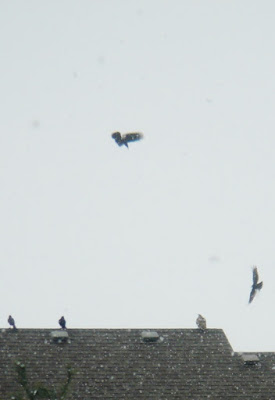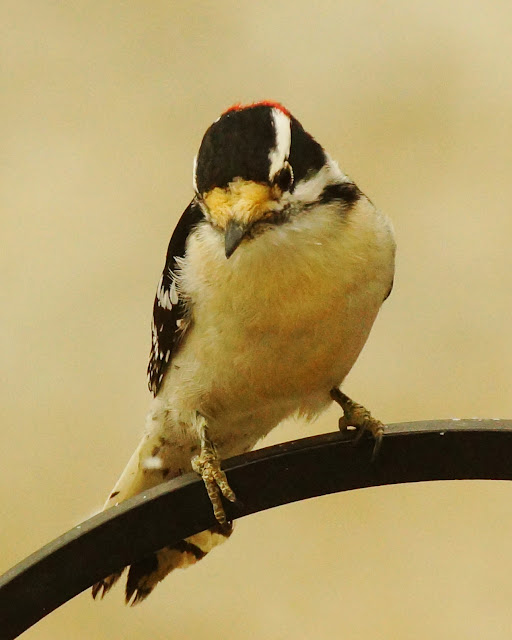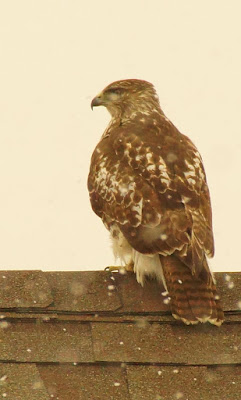3/29/2016
alarm calls in the woods
The raptor Coopers Hawk came to the water bowl for a drink, then dropped his tail feathers into the cold water while looking around for dinner.
All the songbirds freeze in place and get very quiet when a raptor appears. They don't want to be seen or heard, for fear of becoming a raptor's meal.
Read a fascinating article about alarm calls that birds make to alert others of a raptor hunting in the area . . .
https://www.allaboutbirds.org/look-out-the-backyard-bird-alarm-call-network/
3/23/2016
3/04/2016
feathers of Downy Woodpeckers
Downy woody Picoides pubescens
is the smallest woodpecker of the wild wild woods. We see two or three at a time, searching up and down the trees for insects within the folds of bark.
The nasal bristles (stiff yellow feathers above the beak) keep wood crumbs out of the bird's nasal openings as he searches for food or excavates a nest hole in a tree.
Downy Woodpeckers stop at the water bowl too, where this tiny feather was left behind. It may be from the top of this male's head.
a murder of crows

This hawk was gliding over the feeder garden looking for breakfast. The American Crows, who had been snatching peanuts from the tray feeder, gave chase. The hawk landed on a nearby roof. The crows dive-bombed in an effort to scare the hawk away. The hawk calmly waited, squawked a few times, then lifted off towards the river for a better chance at hunting.
3/03/2016
feet and beak
We heard the shrill whinnying calls of the male Pileated Woodpecker Dryocopus pileatus as he made his way through the woods, then came to the suet block for breakfast. He thrust his strong beak into the food, scattering some crumbs to the ground and gulping a few pieces into his gullet. Once he had a mouthful, he went to a nearby tree where he used the rough bark to hold the suet as he consumed it. His tongue has a spear-like tip bearing backward-facing barbs that allow him to lick food items from between the folds of tree bark. Pileated Woodpeckers' favorite food is carpenter ants; also other ants, wood boring beetle larvae, termites, flies, caterpillars, cockroaches, grasshoppers, wild fruits and nuts.
Woodpeckers have zygodactyl feet (two toes facing forward, one facing back) and allows these birds to easily climb and grasp bark, tree branches and other structures.
2/14/2016
GBBC
19th annual Great Backyard Bird Count -- in the wild wild woods today, Mourning Dove, Pileated Woodpecker, Red-bellied Woodpecker, Hairy Woodpecker, Downy Woodpecker, American Crow, Bluejay, Black-capped Chickadee, White-breasted Nuthatch, Junco, Northern Cardinal, European Starling, House Finch, Goldfinch, House Sparrow. Lastly, at dusk, this Sharp-shinned Hawk came by to get his name on the list.
2/05/2016
winter starlings
These two European Starlings have been coming to the suet feeders for a week or so. Their Latin name Sturnus vulgaris is fitting, since these non-natives are considered a vulgar nuisance when they mob lawns in big, noisy flocks. They appear black, but up close their feathers are dazzling iridescent blue, purple, gold, and green. Fortunately, just these two so far near the wild wild woods . . .
Studies of Starlings' mob movements have found that starling flocks model a complex physical phenomenon, seldom observed in physical and biological systems, known as scale-free correlation. Read more at starling murmurations
2/02/2016
redpolls
Today, just as the heavy snow started falling, two Redpolls showed up at the feeder garden. They darted often back into the woodland edge for cover, but snatched many seeds from the tray alongside the Chickadees, Cardinals, and Juncos.
Redpolls breed worldwide in the far northern latitudes. But they come "south" when food is unpredictable in late January. Their winter range is extremely variable (as far south as Iowa or Missouri) when these little birds seek food from open woodlands, scrubby and weedy fields, or backyard feeders.
They can survive temperatures of 65F below zero degrees: they will add about 31 percent more plumage by weight, and tunnel into snow for shelter.
1/09/2016
the old fence row
In gardening season,
I found buried several
pieces of the old barbed
wire that used to be the
fence row when this was
farmed land.
The pieces stand by,
relieved of duty.
1/08/2016
snow on Joe Pye Weed
The seedheads of Joe Pye Weed stand at the edge of the woods. When nibbling these seeds, the Goldfinches nearly disappear by blending in with the dried leaves and seed pods. With a blanket of sticky snow, the pods became "cotton balls" overnight!
1/01/2016
Pileated woodpeckers
| Female: red crest on back half of head |
| Male: red crest on entire head plus red "moustache" |
Every week we see a Pileated Woodpecker Dryocopus pileatus in the woods, or on the suet feeders at the edge of the woods. Today both a male and female were searching up and down the tree trunks for insects. Each bird is 15 to 20" long, with a wingspan of 26 to 29". A pair may stay together year around; they'll begin excavating a nesting hole in late March.
12/29/2015
insulation for insects
A fallen tree in the wild wild woods has become a feeding trough for critters and birds.
(See "insect picnic" posted on 7-20-15)
Now, after a few more inches of snow, any insects or larvae still nestled in the trough will be cozy with a white blanket to insulate them; later, the birds will surely find nourishing meals there.
(See "insect picnic" posted on 7-20-15)
Now, after a few more inches of snow, any insects or larvae still nestled in the trough will be cozy with a white blanket to insulate them; later, the birds will surely find nourishing meals there.
12/27/2015
critter tracks
Now that some snow blankets the ground, we can easily see tracks in the woods. Rabbits, grey squirrels, red squirrels, mice, chipmunks, various birds, and white-tailed deer left tracks -- visible today as the sun lowered in the west. Even the neighborhood cat made her mark while searching around the brush pile.
12/23/2015
suet breakfast
Today the male yellow-shafted Northern Flicker Colaptes auratus visited the suet block for breakfast. It was a wet foggy winter morning; maybe he could not find enough ants, his favorite food, so suet would suffice for energy.
Flickers often search for ants underground, hammering at the soil the way other woodpeckers drill into wood.
12/09/2015
hawk hunting
Today we spotted the Sharp-shinned Hawk at the feeder garden, probably hunting.
The raptor perched for a while on top of one feeder pole, then on the garden fence, then on the water bowl. It turned its head side to side, up and down, looking for any prey possibilities. Finding none, the hawk flew away to try another spot.
12/07/2015
winter blooms
This winter is slow to chill Minnesota. The "trumpet vine" Lonicera 'Major Wheeler' is still blooming! Not just hanging-on old blossoms, but fresh blooms. Usually, the entire vine has dropped leaves and spent blossoms by now. This autumn, El Niño has brought consistent warm mid-40's weather instead of several hard freezes.
 |
| photo taken December 6, 2015 |
nuthatch
Usually we see Nuthatches walking UP a vertical tree trunk or hitching DOWN a steeply slanted tree branch, pecking insects he finds in the bark.
Today, the Nuthatch Sitta carolinensis sat like a songbird, perched on a twig. With such warm winter weather, the meager snow so far is all melted and the insects must still be plentiful.
12/01/2015
bird feeder garden
The veggie plot converts to a bird feeder garden in winter. The edible crops have been harvested. The perennials reach down to overwinter, and the herbs offer up their stems and seed heads for the birds. The feeders beckon the birds; we deter the squirrels from the bird food with a toy "slinky" hung on each slippery pole.
11/27/2015
first snow
The first snow this season was just a dusting to make things look a bit like winter in Minnesota. It placed little white caps on the black chokeberry Aronia melanocarpa fruits still hanging on the shrubs, and on all the various seedheads we left standing for the birds to enjoy all winter.
11/24/2015
roosting hawk
Dusk, yesterday. A hawk glided in over the bird feeders and landed on a branch of the big elm tree. A perfect place to peer down into the wild wild woods, scanning for mice. Then the big bird turned around, looking down on the several seed feeders and suet cakes. But it was nearly dark -- even the late-feeding Northern Cardinals were finished. The hawk scanned a bit this way and that, then fluffed feathers and settled down to cover feet with feathers. Turning its head a few more times, it tucked its beak into a shoulder to roost for the night.
I looked out a few times through the evening. The hawk stayed on the roost. Moonlight made its breast glow among the tangle of twigs. Wondered, as I fell asleep, how long the hawk would stay.
At dawn, I peeked out. The hawk was still cozy, not moving. Two gray squirrels scampered up and down on branches near the hawk. Chattering together, they scolded the hawk for being in their tree. The hawk squawked and revealed its claws. The argument went on for seven minutes. The hawk flew away to find breakfast in a neighborhood NOT guarded by squirrels who protect the songbirds that share seed, suet, and peanuts with them.
11/02/2015
November blossoms
Warmer-than-average weather this autumn! Many perennials are still standing and even blooming in the gardens and woods.
The raspberries are still going strong; several canes are blooming with vigor as if it is August.
9/19/2015
mushrooms in the woods
The summer weather has been wonderful, and with frequent rain lately the mushrooms are numerous. I have not studied that chapter in nature yet, so just admire them for their beauty! These were in the woods along the path near some fallen logs.
9/18/2015
snag tree
The southeast side is bald, revealing its value to the wildlife that live in the woods. In cold weather, birds shelter overnight in the old woodpecker holes. In nesting season, it becomes home to at least one new clutch of avian eggs. The woodpeckers and nuthatches find nutritious insects hiding among the crevices. Today, it harbors a nut storehouse and a cozy grass-lined den for some critter.
| A pile of peelings from Bitternut Hickory nuts. |
| Peeled nuts stashed in a hole of the snag. |
9/04/2015
9/01/2015
blue vervain
Blooming in late summer, the Blue Vervain's tiny 1/4" flowers grow on floral spikes about 5" tall. This native plant Verbena hastata appeared in the part of the woods recently cleared of invasive buckthorn and some other trees. As often happens when buckthorn is cleared, the increase in sunlight makes way for native wildflowers to thrive.
Subscribe to:
Posts (Atom)











